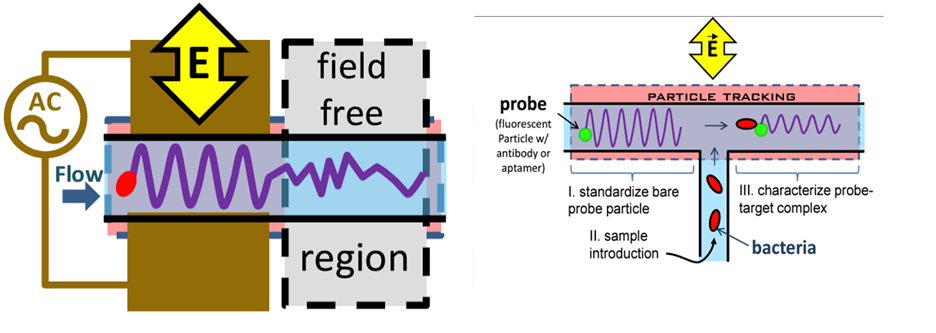A microfluidic system that uses transverse alternating-current (AC) electrophoresis for multi-parameter analysis of single biological particles including mammalian or bacterial cells.
Problem:
With broad distributions of bacterial species in the human gut microbiome, there is a growing need for characterization methods capable of obtaining the signatures of complex bacterial communities. Currently, there are insufficient methods available to characterize bacteria from other samples, especially those that are capable of bacterial sorting. While modern methods such as metagenomics or metatranscriptomics can detect range and diversity of bacteria in the microbiome, the methods are limited by their ability to measure shifts in composition to functional changes. Thus, there is a need for a tool capable of not only obtaining bacterial signatures, but also of tracking changes in composition for longitudinal studies. Finding such methods will allow for better characterization of human gut microbiomes and have great implications for host health.
Solution:
This disclosure presents a microfluidic system using electrophoresis for multi-parameter analysis such as charge, shape, size, and deformability for single bacterial cells. This methodology provides advanced physical analysis while being compatible with current microfluidic sorting technology used in research. The technology has potential to also bridge classical physical characterization with current molecular analyses such as single-cell genomics. When coupled to downstream sorting, the physical characterization of the technology can be utilized to bypass repetitive isolation of biological species higher in abundance.
Technology:
The inventors leverage transverse AC electrophoresis in a microfluidic system for physical characterization, a novel process combining particle tracking velocimetry and AC electrophoresis. By applying electric waves transversely to bulk flow, particles oscillate allowing for characterization of size and charge through particle oscillation. By modulating the parameters of the electric field and timing of application, hydrodynamic shape and deformabilities can be further collected. Large dimensions in the microchannel of the microfluidic device allow for facile characterization without clogging of the device and averaging multiple wave cycles allows for increased precision in characterization.
Advantages:
- Characterizes a single bacteria’s charge, size, shape, and deformability in a single analysis
- Avoids water hydrolysis and bubble production for facile characterization with short inter-electrode distances
- Can acquire fecal microbiome signatures rapidly (in minutes to seconds) and inexpensively (uses commercial materials)
- Has potential to be extended for use in other biological particles such as mammalian cells and virion

Overview of the transverse AC electrophoresis microfluidic system: (Left) schematic of the microchannel used in the device; and, (Right) the integration of on-line labeling.
Intellectual Property:
- Utility Patent Application 18/587,324 Filed
Case ID:
22-10005-tpNCS
Web Published:
5/8/2024
Patent Information:
| App Type |
Country |
Serial No. |
Patent No. |
File Date |
Issued Date |
Expire Date |